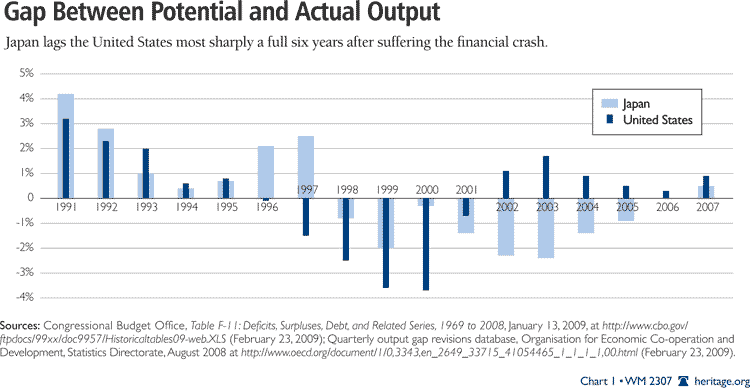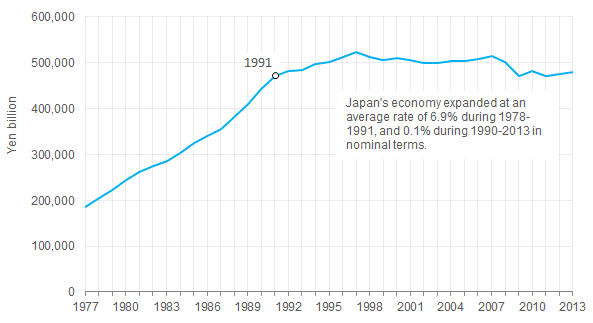What the Learn from Japan s Lost Decade
Post on: 12 Сентябрь, 2015 No Comment

By studying how Tokyo dealt with its decade-long slump, Washington may be able to avoid Japan’s mistakes and engineer a quicker recovery
Ever since the U.S. financial crisis began in August 2007, policymakers have reassured us that the U.S. knows better than to repeat the mistakes Tokyo made during Japan’s Lost Decade of the 1990s. The ill health of Japan’s financial system caused an economic slump to stretch on for years. But as weakened U.S. banks hoard cash rather than lend, such talk is beginning to ring hollow. At the annual meeting of the American Economic Assn. in San Francisco on Jan. 3-5, several leading economists argued that the U.S. is in danger of getting stuck in the same hole.
The message from San Francisco is being heard in Washington, where the incoming Obama Administration is making economic recovery priority No. 1. Economists say Obama must devise a strategy to repair the financial system as quickly as possible so the economy can stage a normal recovery. The key will be pumping plenty of capital into the healthier banks and shutting down the sickest ones. Doing so will give the private sector the confidence to invest in the surviving banks so they have the money to lend normally once again.
The chief lesson from Japan, scholars say, is that good monetary and fiscal policies are necessary but not sufficient for a recovery. The government also needs to spend political capital by taking on entrenched interests: the management, shareholders, and debtholders of big but unhealthy banks that need to be shut down so the financial system can get a fresh start. That campaign must start with a cold-eyed audit of the books of every major institution. We have not closed down banks ruthlessly. That’s the big problem, says Harvard University’s Kenneth Rogoff, who delivered a paper at the San Francisco meeting. We railed at Japan for not giving tough love to its financial institutions, but we’ve had a lot of trouble doing that ourselves.
Business Goodies At least the monetary and fiscal pieces of the solution are being put in place. In December the Federal Reserve cut its target for the federal funds rate to an unprecedented low of zero to 0.25%. It also has begun a campaign to lower mortgage rates by buying up to $600 billion of mortgage-backed securities and agency debt. The Fed is even considering an idea that Japan rejected: committing to a specific target above zero for inflation. That would guard against potentially disastrous deflation. The idea was broached at the Fed’s mid-December Open Market Committee meeting, according to minutes released on Jan. 6.
On the fiscal side, President-elect Obama is negotiating with Congress on about $775 billion in tax cuts and increased government spending over two years. Business goodies in the package may include a so-called bonus depreciation. This measure allows profitable companies to write off investments more quickly. Another proposal getting attention is a one-year tax credit for companies that hire new workers. Obama’s team is betting a $300 billion package of targeted tax cuts will set the stage for sustained recovery. Fiscal conservatives in the U.S. worry about huge deficits, but one lesson from Japan is that halfway recovery measures lead to years of subpar growth that make deficits even bigger.
When it comes to fixing the financial system, it’s eerie how closely the U.S. seems to be following in Japan’s footsteps, only at an accelerated pace. Although the Japanese crisis started with a decline in real estate prices that began in 1990, the financial troubles didn’t become acute until 1997. The government injected capital into banks in 1998, but not enough. Efforts intensified in 1999: The government put more capital into banks and began buying loans from them, while the Bank of Japan lowered overnight interest rates to near zero. In 2001 the government started trying to fix the finances of the banks’ borrowers. Along the way there was a lot of deficit spending, including on the original bridges to nowhere that connected lightly populated islands.
Rapid-Fire Rescues It was only in 2002, when Japan began restructuring banks in earnest, that it finally began to get its act together. The turning point was the appointment of crusading economist Heizo Takenaka to head the government’s financial reform efforts. The so-called Takenaka Plan toughened audits of banks, forcing them to write off bad loans and raise capital. Weak ones were merged into stronger ones.
The parallels to Japan were spelled out at the conference in San Francisco in a widely noted paper by Anil Kashyap of the University of Chicago Booth School of Business and Takeo Hoshi of the University of California at San Diego and the Tokyo Center for Economic Research. Both are longtime scholars of Japan’s banking system.
Kashyap says the U.S. began to resemble Japan—in a bad way—this fall after the rapid-fire series of rescues of Fannie Mae (FNM ), Freddie Mac (FRE ), AIG (AIG ), Citigroup (C ), and others. The market guys always want to rescue everyone, but you can’t socialize all the losses, he said in a Jan. 6 interview. It has become conventional wisdom that it was a huge mistake for the government to let Lehman Brothers go under, but Kashyap said, I don’t think it’s so obvious that if you had saved Lehman, no one else big would have failed. The bigger mistake, he said, was taking an ad hoc, inconsistent approach that has left the private sector confused about which institutions are safe to invest in, thus chilling capital-raising.
Another Wave of Defaults Japanese experts see tough times for the U.S. If you have to learn a lesson from Japan, you have to learn that it will take a long time to recover, says Eisuke Sakakibara, a former senior Finance Ministry official and now a professor at Waseda University. Adds Seiji Shiraishi, chief economist at HSBC Securities (HSBC ) in Tokyo: The [U.S.] authorities’ reactions have been fast, but I am not sure how forward-looking they were. I think the coming years will be severe.

The takeaway from Japan—and from the U.S. experience with the savings and loan bust of the late 1980s and early 1990s—is that the best hope to ameliorate the crisis is to get finance functioning normally. That’s a tall order given the huge wave of defaults on home mortgages, commercial real estate loans, and credit cards that’s coming in the next two years.
Judging from Japan’s experience, even the stronger banks are going to need more big capital infusions to make up for the losses they’ll suffer. Uncle Sam will have to assume the obligations of weaker banks, gradually selling their loan portfolios at a loss to taxpayers. The government may also have to restructure some nonfinancial companies, such as carmakers and retailers.
All this will be expensive and politically treacherous. Among other things, Japan’s experience indicates there has to be a sturdy safety net for people who lose jobs in the shutdown of moribund companies. As big as it seems, Obama’s stimulus is likely to be just a down payment. The U.S. has moved more rapidly than Japan, in part because its crisis is both faster and deeper. It remains to be seen whether it’ll be able to spring back more quickly as well.
With Ian Rowley in Tokyo and Jane Sasseen in Washington.
With Ian Rowley in Tokyo and Jane Sasseen in Washington.
Coy is BusinessWeek ‘s Economics editor.














